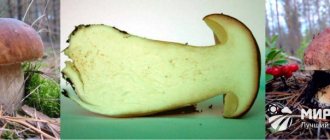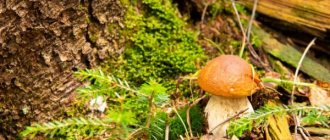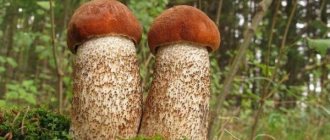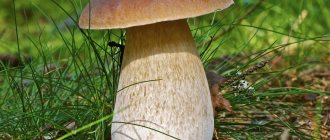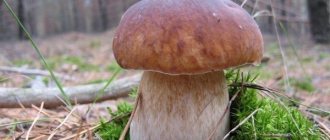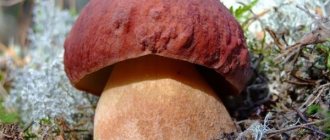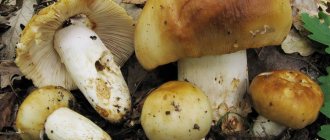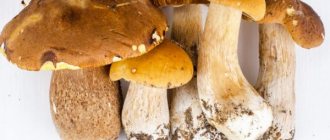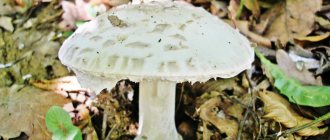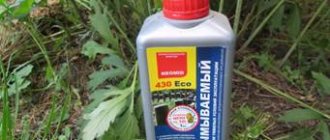Boletus is the most desired object of mushroom pickers, belonging to the first category in terms of taste. But you should only add it to the basket if you are absolutely sure that it has been correctly identified. After all, it has an insidious double - a false porcini mushroom, and the photo clearly shows how similar they are - you can only find the differences in a detailed description.
Other names for the double are also used - bitter, bitter, gall, obtained due to the fact that it tastes bitter and cannot be removed even with prolonged soaking and heat treatment. But at the same time, bitters are not poisonous, but simply inedible. Boletus also has other doubles: satanic boletus, beautiful boletus, speckled oak boletus.
Description of the false porcini mushroom
Gorchak (gall mushroom) is inedible. It cannot be used in cooking, and this is not only due to the unpleasant taste. In appearance, it is very similar to a real boletus, so inexperienced mushroom pickers often confuse them.
What does bitterling look like?
The structure of the bitter mushroom is almost identical to that characteristic of the true porcini mushroom. Main parameters:
- Leg. It grows to 5-13 cm in height and 1.5-3 cm in thickness. Its upper part is usually colored creamy yellow or whitish. The surface is decorated with a brown or blackish mesh, the base is swollen and fibrous. Its main part is cylindrical or club-shaped.
- Hat. In young fruits it is hemispherical, but as it matures it becomes more prostrate and rounded-cushion-shaped features appear. In dry weather, the cap surface is slightly pubescent, but during rain it becomes slippery. Its shade can be yellowish-brown, dark brown, gray-ocher.
- Pulp. It is whitish in color and has a rather impressive, massive appearance.
Important! Gorchak is widely used in folk medicine as an effective choleretic agent. But it cannot be used as a nutritional element, and the point is not only the bitter taste, which disappears after 12 hours of soaking. It still contains toxins that can seriously harm liver health.
Places of distribution
Favorite places for bitterlings to grow are:
- conifers;
- sandstones;
- zones with light loamy or slightly acidic fertile soil.
Sometimes bittergrass can be found on half-rotten stumps or tree bases. Such fruits usually grow in groups, but can also settle individually. The period during which mushrooms can be found lasts from the beginning of summer to the end of September (or until the onset of the first frost).
White boletus: nutritional qualities and traditions of consumption
The nutritional value of porcini mushrooms is not exceptional. Other edible mushrooms are comparable in composition and nutritional value to boletus, or even superior to it. The value of porcini mushroom lies in its excellent taste and ability to stimulate the digestive system.
Since the boletus boletus is found everywhere in Europe and the northern part of Asia, all the peoples of this natural area have culinary traditions associated with this mushroom. Moreover - an interesting detail. Since we are talking mainly about Christian states, where meat is not allowed during religious fasts, but mushrooms are acceptable, boletus mushrooms have become the main substitute for meat products. Many researchers believe that Europeans developed the habit of eating mushrooms mainly thanks to boletus mushrooms, which replaced meat.
In the countries of Eastern Europe, including Russia, one can even talk about some kind of culinary cult in relation to the porcini mushroom. Unlike Western Europe, where there are few forests left and most people have no idea what boletus looks like, we still have many places where wild mushrooms are abundant. In the pre-industrial era, almost every village family stored tens of kilograms of dried and pickled mushrooms for the winter. And the lion's share of them were boletus mushrooms.
Today in Russian villages they continue to dry and pickle porcini mushrooms, although in much smaller quantities. But in cities where three quarters of the population live, this tradition has practically been abandoned. Of course, yellow boletus is still very popular, but it is eaten mainly fried and boiled. Only a few city residents make small stocks of pickled mushrooms for the winter.
How to distinguish a real porcini mushroom from a false one
When collecting true boletus mushrooms, especially if you do not know what their counterparts are, you should not be guided only by their appearance. Often, in order to distinguish a real fruiting body from a false one, it is necessary to carry out certain additional procedures.
Remember!
The main criterion by which bitter bitter is distinguished from a true white fruit is taste. Its counterpart is bitter, which is why it got its name. But since it is strictly forbidden to try unfamiliar mushrooms, this option for recognizing inedible mushrooms disappears immediately.
You shouldn’t immediately be at a loss as to whether it’s possible to eat a mushroom that a novice mushroom picker comes across in the forest. To understand whether it is bitterling or boletus, you need to carry out the following tests:
- Cut the fruit with a knife and pay attention to the color of the pulp that is adjacent to the ground. For a true boletus, it will remain unchanged. At the same time, in bitterling it will immediately begin to darken. The hue will become pinkish-brown, and this should be the reason for refusing to further collect such fruits.
- Examine the stem of the plucked fruiting body. A real boletus does not have the characteristic mesh that its double has. But the birch tree may still have dark scales on the stem, similar to the color of a birch trunk.
- Examine the bottom of the mushroom cap. The bitterling has a tubular layer of a dirty pink color, while the boletus has a tubular layer that is white, grayish or yellow.
Helpful advice!
You can also pay attention to the condition of the pulp and mushroom cap. Boletuses have a pleasant smell and taste, which is why forest insects, animals and worms love them. For this reason, their flesh often shows passages or damage characteristic of bites. But mustard has a pungent, bitter taste, so almost always such mushrooms remain untouched.
Spreading
Quite often found in Northern European countries, Canada, and Russia. False white has also been reported in parts of Asia and China. These mushrooms appear in summer and autumn from June to October or even November. They grow in well-drained acidic soils, which can be sandy, gravelly or peaty.
They can be found in damp places, swampy areas and where there are a lot of fallen leaves. Fruiting bodies also grow in the cavities of old trees, on old pine stumps or on fallen trunks. Yields are unstable. In some years a large number of mushrooms may appear, but in others not. As a rule, the yield depends proportionally on the amount of precipitation.
Important! Mushrooms can be affected by the mold Sepedonium ampullosporum. Infection results in necrosis of the fungal tissue and a yellow discoloration caused by the production of large numbers of pigmented conidia (non-motile spores).
Varieties of mushrooms similar to porcini
There are several other varieties of fruits that are similar to boletus. But not all of them are as dangerous as bitterweed. Some mushrooms can be used in cooking.
White breast
White milk mushrooms have a flat, then funnel-shaped cap, the color of which can vary from milky white to yellowish. There is a small but noticeable fringe along the edges of the hat section.
The fetal leg is thick and has a cavity inside it. The flesh is white in color, and if you cut it, a milky juice begins to stand out, which has a very pungent taste and tends to quickly turn yellow when exposed to air. The flesh of the mushroom is whitish and smells like fruit.
In Europe, this fruit is considered inedible, but in Russia it is widely used for pickling.
To summarize
Now you know how to distinguish a false porcini mushroom from an edible boletus mushroom. Be sure to rewrite or learn the ideas and ways to distinguish between these two mushrooms listed in the article. On your first trips, it is advisable to take with you an experienced mushroom picker who will tell, show, teach and share his experience. And most importantly, he will make sure that you don’t make mistakes at first. Write your questions and opinions regarding this mushroom in the comments below. Happy mushroom hunting, goodbye!
Mushroom that turns blue when cut
Mushrooms that turn blue when cut and thus differ from true boletus are beautiful boletus and speckled oak.
Boletus is beautiful
The beautiful boletus can have different colors of the cap section:
- light brown;
- olive-light brown;
- brown;
- grey-brown.
The surface is smooth, dry, matte, sometimes wrinkled. The diameter of the cap can be 4-15 cm.
In young fruits, the stem is barrel-shaped, then becomes club-shaped or cylindrical. It can grow up to 3-15 cm in length and from 1 to 4 cm in thickness.
The pulp is quite dense and hard. It has a light cream color, but turns blue when cut. The taste of the mushroom is very bitter and pungent, so it is not eaten.
Speckled oakweed
Main characteristics of speckled oakwood:
- Hat. It has a pillow-shaped or hemispherical shape, does not exceed 5-20 cm in diameter. Its surface is matte, velvety, dry. But in some fruits it is mucous. The color can vary from dark brown to dark brown. If you press on the flesh of the cap, it will become darker or bluish.
- Leg. Quite wide, thick and massive. The shape is tuberous, cylindrical or barrel-shaped. Its length is 5-15 cm, thickness - 1.5-4 cm.
- Pulp. The color is bright yellow or yellowish, has no pronounced smell or taste. When cut, it immediately begins to turn blue.
On a note.
Speckled oak trees love acidic soil. You can find them in places where spruce, beech, oak, and fir grow.
boletus
The cap of this mushroom is grayish, brownish or brown. It looks like a swollen pillow, and reaches 4-12 cm in diameter. The leg has a white or grayish color and is scaly. Its thickness is 1.5-4 cm and tapers towards the top.
Real boletus is suitable for consumption. But it is very similar in appearance to the gall fungus, so it is important to be able to distinguish between these species.
Boletus net
Sometimes this fruit is called one of the varieties of true boletus, suitable for consumption. In principle, this mushroom is also edible, very tasty and even valued almost as much as white mushrooms.
The cap of a young mushroom is initially hemispherical, but as it matures it becomes convex. Diameter from 6 to 30 cm. The skin is colored brown. Its surface is matte and velvety. At first dry, with age it becomes covered with many cracks.
The pulp is highly dense, fleshy, and does not change color when cut. The leg is also dense and thick, brownish in color and decorated with a large mesh pattern. The mushroom has a characteristic smell and a nutty or sweetish taste.
Bronze boletus
The cap of young mushrooms is dense and hard, but noticeably softens with age. The leg has a uniform structure. Its height varies between 9-12 cm, and thickness - 2-4 cm. If you cut the flesh of the leg, it will darken noticeably, but blueing is not typical for it.
Satanic mushroom
The satanic mushroom is a poisonous fruit, although some sources call it conditionally edible. It has a cushion-shaped cap, 10-20 cm in diameter. In color, it can be grayish-white or pale ocher-white with an olive tint added. Dry to the touch, quite dense and fleshy.
The flesh is white and immediately begins to turn blue when cut. It has a faint spicy odor in young mushrooms. The leg grows in height from 6 to 10 cm, is bordered with a mesh pattern, and has an unpleasant odor, especially in more mature fruits.
On a note.
The satanic mushroom is often confused with the edible oak mushroom. Therefore, when collecting such fruits in areas where oak trees grow, special care must be taken.
Main differences in appearance
The flesh of the mustard mushroom is fibrous and either has no smell at all or gives off a slight mushroom smell. The stem of this mushroom has a cylindrical shape, the base is somewhat swollen. The height also depends on age - from only 3 centimeters for a newborn mushroom, and up to 14 centimeters for an adult mature mushroom. While the mushroom ripens, the stem is gradually covered with a fine mesh, which is made up of small brown or grayish fibers. The shape of the pores of bitterling is round, sometimes somewhat angular.
The gall fungus has one feature that completely gives it away - as soon as you cut off the mustard, the cut area immediately begins to become covered with a brown tint and darken. Is it possible to distinguish it from the real thing? Signs that allow this to happen:
- The main feature that distinguishes the gall mushroom from the real white and edible boletus is its bitter taste. To feel it, you don’t need to taste the mushroom you find—just lick it and everything will become clear. Neither real white nor boletus has any bitterness. In addition, the tongue will feel a slight burning sensation caused by the substances contained in the mushroom.
- The flesh of a cut gall mushroom immediately darkens, acquiring a pink-brown color. This does not happen with a real porcini mushroom, just like with boletus - the flesh remains the same white color. Only in the pinking boletus does the color scheme of the flesh undergo changes - it becomes pinkish.
- Another difference between the gall mushroom: the leg is decorated with a pattern similar to a brown mesh. Real white does not have such a pattern. And on the leg of the boletus there are scales of white and black colors, arranged so that it resembles a birch trunk. The only thing is that the bronze and reticulated boletus have a similar mesh, only it is less dense and has a different appearance.
- The tubular layer of the gall fungus is white (on young ones) or, for the most part, pink and dirty pink (on adults). The true edible porcini mushroom has a tubular substance that is white, slightly yellowish, or gray in color. True boletus mushrooms have a whitish-gray tubular layer; in old mature mushrooms it is brown.
Gorchak grows in Russian, American and European forests of any type - both coniferous and deciduous. It forms a kind of mycorrhiza with deciduous (oak, aspen, birch) and coniferous trees. The first gall mushrooms appear in June and remain in the forests until the first October frosts. They grow under a tree, forming a symbiosis with the root system, and are found on rotten stumps, often in groups of 5 to 15 pieces, less often singly.
Interesting read: How to pick mushrooms correctly: cut or twist.
Why is false white mushroom dangerous?
The danger of such a fruit lies in its inedibility. However, bittersweet does not contain poisons as such, although it can still cause poisoning. Another distinctive feature of this species is the presence in its composition of toxins that destroy liver cells.
But it is impossible to be poisoned by gall fungus immediately after it enters the body. Firstly, due to the most unpleasant taste of this fruit, it is simply unrealistic to eat it in large quantities. Secondly, to provoke serious intoxication, a high concentration of toxic elements must enter the blood.
Edibility
Although false white is not poisonous, most reference books define it as inedible due to its bitter taste. The same pungent taste properties contribute to the fact that in some countries it is dried in small slices and used instead of pepper. The bitterness of bittersweet cannot be eliminated, and heat treatment only intensifies it.
Did you know? The Russian name “boletus” is derived from the place where these mushrooms can be found in abundance - in a pine forest.
Symptoms and first aid for poisoning
You may be interested in: How do edible talkers differ from false mushrooms? How many days after rain do mushrooms grow? Bitter mushroom: photo and detailed description
Mushroom poisoning is difficult, but possible, and in this case it is necessary to know how it manifests itself. The first symptoms may appear after a few days or weeks, and be accompanied by:
- dizziness;
- weakness;
- nausea;
- bitterness in the mouth;
- discomfort in the liver area;
- loss of appetite;
- vomiting;
- abdominal pain;
- diarrhea.
All these symptoms are directly related to toxic liver damage. Despite the fact that the condition often stabilizes on its own, experts say that if such ailments are not paid attention to, then over time the situation can only worsen, since bitter bitter poisoning can lead to hepatitis.
There are no specific first aid measures in this case - only a doctor can help. If necessary, you can drink Regidron solution at home, and also use activated carbon to absorb toxins.
But all further activities can be carried out exclusively by a specialist. In some cases, detoxification therapy may be necessary, as well as a number of procedures aimed at eliminating hepatological complications after consuming bittersweet.
Use in cooking
In cooking, boletus mushrooms are used raw, frozen and dried, in the form of canned food and pickles. They are boiled, fried, stewed, baked. Reviews from porcini mushroom lovers on various forums indicate that it is preferable to use dried boletus mushrooms for preparing various mushroom dishes. The most popular dishes among them are porcini mushroom soup and mushroom sauce. It is in these dishes that they reveal themselves, showing all their taste and aromatic qualities.
Porcini mushroom soup
A handful of dried boletus mushrooms are soaked in milk for 30 minutes, washed thoroughly, then boiled for 15-20 minutes. Fry chopped onions and carrots in a frying pan, then add pre-cooked porcini mushrooms. After frying for 10 minutes, the contents of the frying pan along with the chopped potatoes are poured into the pan. Boil until the potatoes are ready. Served with herbs and sour cream.
Mushroom sauce
A handful of dried forest products is poured with water for 1.5 hours, after which the water is drained and the product is thoroughly washed. After this, add 1 liter of fresh water and cook for about an hour. Fry the onion in a frying pan until golden brown, add boiled boletus, and fry covered for about 15 minutes. Stirring with a whisk, add 3 tbsp. spoons of flour, then diluted with mushroom broth to the desired consistency. Add sour cream, herbs and spices to taste. This sauce goes well with pilaf, pasta dishes, buckwheat porridge, and meat.
There are a lot of recipes for boletus dishes in various forms - these include soups, pilaf, roasts, pates, and sauces. All these recipes share a unique aroma with nutty notes and a memorable rich mushroom taste.
